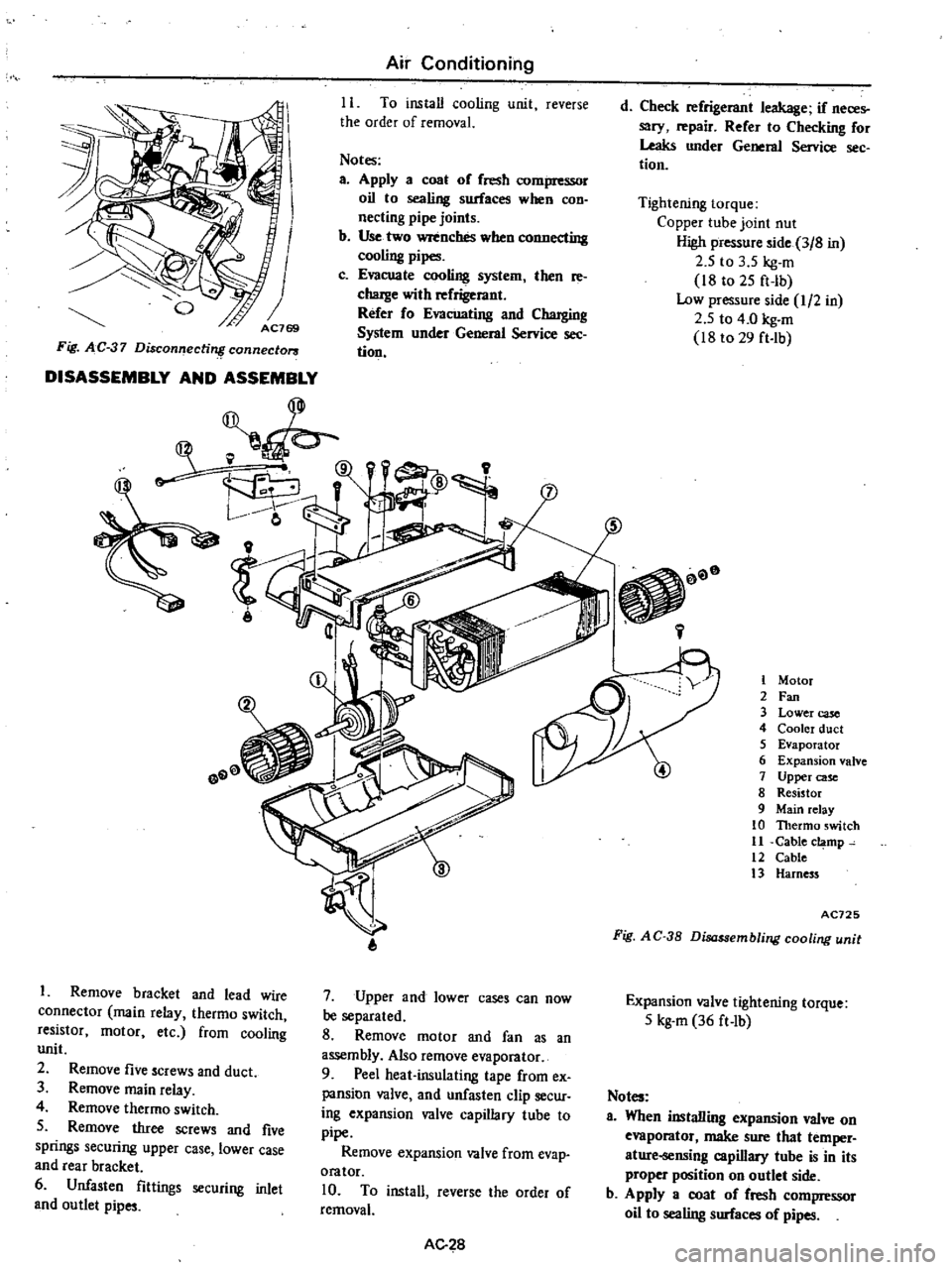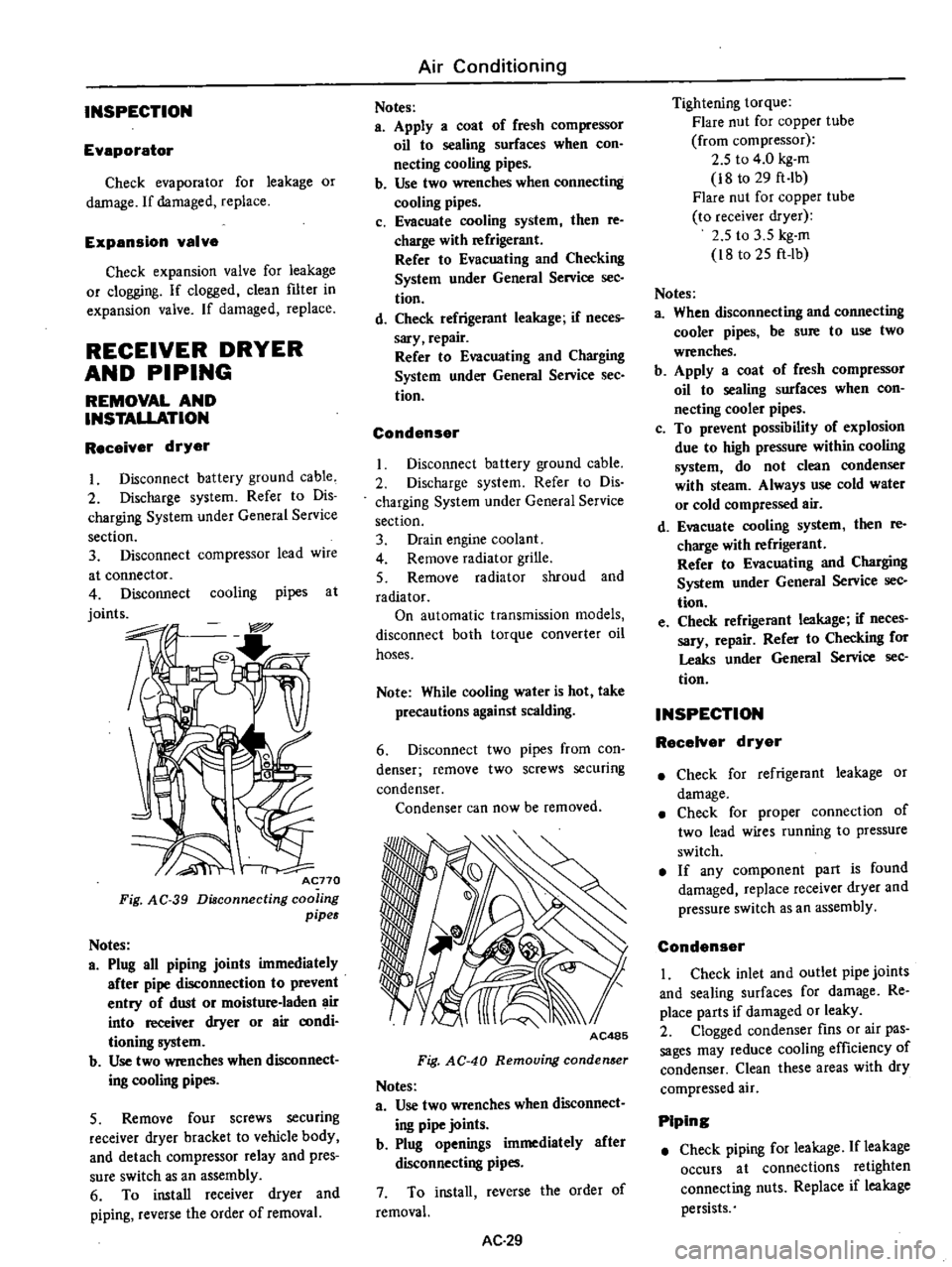charging DATSUN PICK-UP 1977 Owner's Guide
[x] Cancel search | Manufacturer: DATSUN, Model Year: 1977, Model line: PICK-UP, Model: DATSUN PICK-UP 1977Pages: 537, PDF Size: 35.48 MB
Page 517 of 537

I
o
Fig
AC
37
Disconnectirt
connector
3
DISASSEMBLY
AND
ASSEMBLY
I
Remove
bracket
and
lead
wire
connector
main
relay
thermo
switch
resistor
motor
etc
from
cooling
unit
2
Remove
five
screws
and
duct
3
Remove
main
relay
4
Remove
thermo
switch
5
Remove
three
screws
and
five
springs
securing
upper
case
lower
case
and
rear
bracket
6
Unfasten
fittings
securing
inlet
and
outlet
pipes
Air
Conditioning
11
To
install
cooling
unit
reverse
the
order
of
removal
Notes
a
Apply
a
coat
of
fresh
compressor
oil
to
sealing
surfaces
when
COD
necting
pipe
joints
b
Use
two
wrenches
when
connecting
cooling
pipes
c
Evacuate
cooling
system
then
re
chaJge
with
refrigerant
Refer
fo
Evacuating
and
Charging
System
under
General
Service
see
tion
9
7
Upper
and
lower
cases
can
now
be
separated
8
Remove
motor
and
fan
as
an
assembly
Also
remove
evaporator
9
Peel
heat
insulating
tape
from
ex
pansion
valve
and
unfasten
clip
secur
ing
expansion
valve
capillary
tube
to
pipe
Remove
expansion
valve
from
evap
orator
10
To
install
reverse
the
order
of
removal
AG
28
d
Check
refrigerant
leakage
if
neces
sary
repair
Refer
to
Checking
for
Leaks
under
General
Service
sec
tion
Tightening
torque
Copper
tube
joint
nut
High
pressure
side
3
8
in
2
5
to
3
5
kg
m
18
to
25
ft
lb
Low
pressure
side
I
2
in
2
5
to
4
0
kg
m
18
to
29
ft
lb
00
L
1
Motor
2
Fan
3
Lower
case
4
Cooler
duct
5
Evaporator
6
Expansion
valve
7
Upper
case
8
Resistor
9
Main
relay
10
Thermo
switch
11
Cable
c
mp
12
Cable
3
Harness
AC725
Fig
A
C
38
Disassembling
cooling
unit
Expansion
valve
tightening
torque
5
kg
m
36
ft
Ib
Notes
a
When
installing
expansion
valve
on
evaporator
make
sure
that
temper
ature
oensing
capillary
tube
is
in
its
proper
position
on
outlet
side
b
Apply
a
coat
of
fresh
compressor
oil
to
sealing
surfaces
of
pipes
Page 518 of 537

INSPECTION
Evaporator
Check
evaporator
for
leakage
or
damage
If
damaged
replace
Expansion
valve
Check
expansion
valve
for
leakage
or
clogging
If
clogged
clean
filter
in
expansion
valve
If
damaged
replace
RECEIVER
DRYER
AND
PIPING
REMOVAL
AND
INSTAUATION
Receiver
dryer
I
Disconnect
battery
ground
cable
2
Discharge
system
Refer
to
Dis
charging
System
under
General
Service
section
3
Disconnect
compressor
lead
wire
at
connector
4
Disconnect
cooling
pipes
at
joints
Acno
Fig
AC
39
Diaconnecting
coo
ing
pipes
Notes
a
Plug
all
piping
joints
immediately
after
pipe
disconnection
to
prevent
entry
of
dust
or
moisture
laden
air
into
receiver
dryer
or
air
aJOdi
tioning
system
b
Use
two
wrenches
when
dIsconnect
ing
cooling
pipes
5
Remove
four
screws
securing
receiver
dryer
bracket
to
vehicle
body
and
detach
compressor
relay
and
pres
sure
switch
as
an
assembly
6
To
install
receiver
dryer
and
piping
reverse
the
order
of
removal
Air
Conditioning
Notes
a
Apply
a
coat
of
fresh
compressor
oil
to
sealing
surfaces
when
con
necting
cooling
pipes
b
Use
two
wrenches
when
connecting
cooling
pipes
c
Evacuate
cooling
system
then
re
charge
with
refrigerant
Refer
to
Evacuating
and
Checking
System
under
General
Service
sec
tion
d
Check
refrigerant
leakage
if
neces
sary
repair
Refer
to
Evacuating
and
Charging
System
under
General
Service
See
tion
Condenser
Disconnect
battery
ground
cable
2
Discharge
system
Refer
to
Dis
charging
System
under
General
Service
section
3
Drain
engine
coolant
4
Remove
radiator
grille
5
Remove
radiator
shroud
and
radiator
On
automatic
transmission
models
disconnect
both
torque
converter
oil
hoses
Note
While
cooling
water
is
hot
take
precautions
against
scalding
6
Disconnect
two
pipes
from
con
denser
remove
two
screws
securing
condenser
Condenser
can
now
be
removed
AC485
Fig
AC
40
Removing
conden
er
Notes
a
Use
two
wrenches
when
disconnect
ing
pipe
joints
b
Plug
openings
immediately
after
disconnecting
pipes
7
To
install
reverse
the
order
of
removal
AC
29
Tightening
torque
Flare
nut
for
copper
tube
from
compressor
2
5
to
4
0
kg
m
i8
to
29
ft
Ib
Flare
nut
for
copper
tube
to
receiver
dryer
2
5
to
3
5
kg
m
i8
to
25
ft
lb
Notes
a
When
disconnecting
and
connecting
cooler
pipes
be
sure
to
use
two
wrenches
b
Apply
a
coat
of
fresh
compressor
oil
to
sealing
surfaces
when
con
necting
cooler
pipes
c
To
prevent
possibility
of
explosion
due
to
high
pressure
within
cooling
system
do
not
clean
condenser
with
steam
Always
use
cold
water
or
cold
compressed
air
d
Evacuate
cooling
system
then
re
charge
with
refrigerant
Refer
to
Evacuating
and
Charging
System
under
General
Service
sec
tion
e
Check
refrigerant
leakage
if
neces
sary
repair
Refer
to
Checking
for
Leaks
under
General
Service
sec
tion
INSPECTION
RecelYer
dryer
Check
for
refrigerant
leakage
or
damage
Check
for
proper
connection
of
two
lead
wires
running
to
pressure
switch
If
any
component
part
is
found
damaged
replace
receiver
dryer
and
pressure
switch
as
an
assembly
Condenser
I
Check
inlet
and
outlet
pipe
joints
and
sealing
surfaces
for
damage
Re
place
parts
if
damaged
or
leaky
2
Clogged
condenser
fins
or
air
pas
sages
may
reduce
cooling
efficiency
of
condenser
Clean
these
areas
with
dry
compressed
air
Piping
Check
piping
for
leakage
If
leakage
occurs
at
connections
retighten
connecting
nuts
Replace
if
leakage
persists
Page 526 of 537

INSPECTION
Check
for
gas
leakage
as
follows
I
Plug
high
and
low
pressure
joints
on
compressor
with
blind
caps
2
Connect
charging
hoses
in
lines
between
manifold
gauge
and
high
and
low
pressure
service
valves
Connect
refrigerant
can
to
middle
hose
of
manifold
gauge
3
Open
valve
of
can
tap
and
charge
refrigerant
Loosen
oil
filler
plug
at
side
of
compressor
to
purge
air
out
of
compressor
4
Turn
shaft
5
or
6
turns
Then
confirm
that
pressure
does
not
decrease
on
low
pressure
gauge
If
gauge
indicates
a
pressure
decrease
there
is
a
leak
Conduct
a
leak
test
Under
such
a
condition
remove
and
then
install
parts
again
CYLINDER
HEAD
AND
VALVES
Insufficient
refrigerant
compression
is
likely
to
be
caused
by
damaged
head
gasket
or
damaged
valves
Prior
to
servicing
the
head
and
valve
plate
both
service
valves
should
be
opened
to
free
any
gas
pressure
which
may
be
in
the
compressor
REMOVAL
I
Remove
the
bolts
from
flanged
type
service
valves
using
Torx
Driver
Bit
Note
The
direction
of
flanged
type
service
valves
should
be
noted
for
reinstallation
AC812
Fig
AC
66
Removing
service
valves
2
Remove
the
remaining
bolts
in
the
head
Air
Conditioning
AC813
Fig
A
C
6
7
Removing
cylinder
head
bolts
3
Remove
valve
plate
and
head
from
cylinder
by
prying
or
tapping
under
the
ears
which
extend
from
valve
plate
If
head
and
valve
plate
adhere
hold
head
and
tap
valve
plate
ears
away
from
head
with
a
soft
hammer
Note
Do
not
hit
or
tap
head
to
separate
head
and
valve
plate
be
3use
damage
to
head
may
result
Fig
AC
68
Removing
valve
plate
and
head
4
When
removing
the
gaskets
use
a
sharp
edged
knife
Notes
a
In
removing
head
gasket
be
very
careful
not
to
damage
machined
sealing
surface
b
Do
not
reuse
gaskets
AC815
Fig
A
C
69
Removing
gasket
AC37
INSTALLATION
Valves
and
valve
plates
are
furnish
ed
only
as
a
complete
assembly
I
Apply
a
thin
film
of
clean
refrig
eration
oil
on
area
of
crankcase
to
be
covered
by
cylinder
gasket
2
Place
cylinder
gasket
in
position
on
cylinder
so
dowel
pins
in
crankcase
go
through
dowel
pin
holes
in
cylinder
gasket
3
Apply
a
thin
film
of
clean
refrig
eration
oil
to
top
and
bottom
valve
plate
areas
to
be
covered
by
gaskets
AC816
Fig
A
C
70
Applying
clean
refrigeration
oil
4
Place
valve
plate
in
position
on
cylinder
gasket
so
discharge
valve
as
semblies
i
e
smaller
diameter
assem
blies
with
restrainer
over
valve
reed
are
facing
up
and
locating
dowel
pins
go
through
dowel
pin
holes
in
valve
plate
Fig
A
C
71
Placing
valve
plate